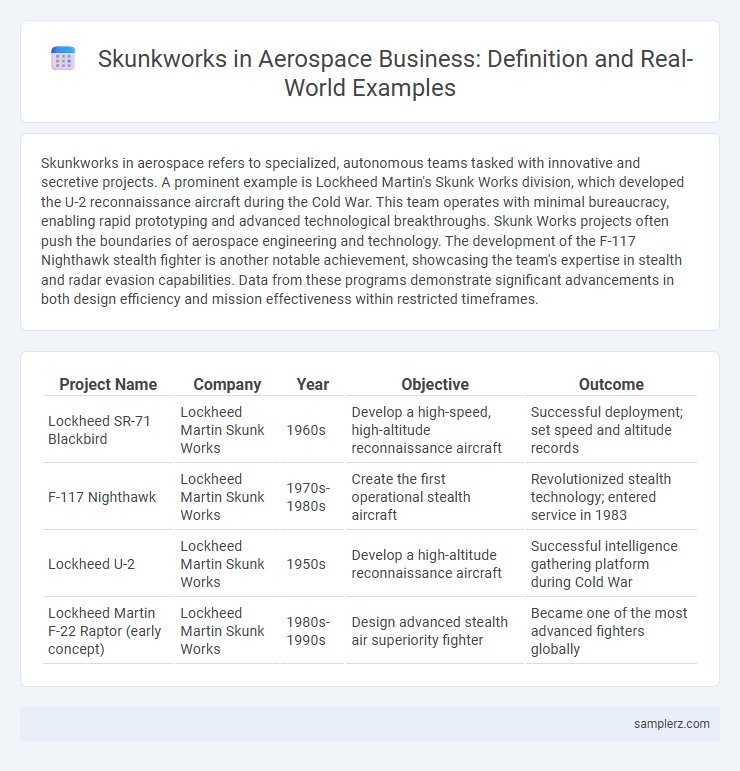Skunkworks in aerospace refers to specialized, autonomous teams tasked with innovative and secretive projects. A prominent example is Lockheed Martin's Skunk Works division, which developed the U-2 reconnaissance aircraft during the Cold War. This team operates with minimal bureaucracy, enabling rapid prototyping and advanced technological breakthroughs. Skunk Works projects often push the boundaries of aerospace engineering and technology. The development of the F-117 Nighthawk stealth fighter is another notable achievement, showcasing the team's expertise in stealth and radar evasion capabilities. Data from these programs demonstrate significant advancements in both design efficiency and mission effectiveness within restricted timeframes.
Table of Comparison
| Project Name | Company | Year | Objective | Outcome |
|---|---|---|---|---|
| Lockheed SR-71 Blackbird | Lockheed Martin Skunk Works | 1960s | Develop a high-speed, high-altitude reconnaissance aircraft | Successful deployment; set speed and altitude records |
| F-117 Nighthawk | Lockheed Martin Skunk Works | 1970s-1980s | Create the first operational stealth aircraft | Revolutionized stealth technology; entered service in 1983 |
| Lockheed U-2 | Lockheed Martin Skunk Works | 1950s | Develop a high-altitude reconnaissance aircraft | Successful intelligence gathering platform during Cold War |
| Lockheed Martin F-22 Raptor (early concept) | Lockheed Martin Skunk Works | 1980s-1990s | Design advanced stealth air superiority fighter | Became one of the most advanced fighters globally |
Origins of Skunk Works in Aerospace Innovation
The Skunk Works division of Lockheed Martin pioneered rapid aerospace innovation during World War II by developing the P-80 Shooting Star, the first operational jet fighter for the U.S. Air Force. Established in 1943, this secretive project emphasized streamlined processes, small teams, and cutting-edge technology, setting a benchmark for future aerospace engineering. The origins of Skunk Works demonstrate how agile, focused research units accelerate breakthroughs in high-stakes aerospace contexts.
Notable Skunkwork Projects in Aviation History
The Lockheed Martin Skunk Works division revolutionized aerospace with projects like the U-2 reconnaissance aircraft, the SR-71 Blackbird, and the F-117 Nighthawk stealth fighter, demonstrating groundbreaking innovation in speed, stealth, and surveillance capabilities. These projects exemplify rapid development cycles and classified engineering that significantly advanced military aviation technology. Skunk Works' ability to deliver cutting-edge solutions under secrecy set industry standards and influenced subsequent aerospace designs worldwide.
How Skunkwork Teams Revolutionized Aerospace Design
Skunkwork teams, such as Lockheed Martin's Advanced Development Programs, pioneered rapid prototyping and secretive innovation in aerospace, enabling breakthroughs like the U-2 and SR-71 Blackbird. These specialized groups operated with minimal bureaucracy, fostering agility and unconventional problem-solving that accelerated technological advancements. Their approach revolutionized aerospace design by emphasizing stealth, speed, and cutting-edge materials, setting new industry standards for performance and innovation.
Case Study: Lockheed Martin’s SR-71 Blackbird Development
Lockheed Martin's SR-71 Blackbird development exemplifies skunkworks innovation, where a secretive team rapidly designed the world's fastest reconnaissance aircraft amid Cold War pressures. Utilizing advanced stealth technology and cutting-edge materials, the project delivered unprecedented speed and altitude capabilities, reaching Mach 3+ at 85,000 feet. The SR-71 program demonstrated how autonomous teams with minimal bureaucracy accelerate aerospace breakthroughs and maintain strategic advantages.
Boeing’s Phantom Works: A Modern Skunkwork Example
Boeing's Phantom Works exemplifies a modern skunkworks operation, focusing on advanced aerospace innovation and rapid prototyping. This division operates with high autonomy to develop cutting-edge technologies such as autonomous systems, hypersonics, and space exploration solutions. By leveraging agile methodologies and cross-disciplinary teams, Phantom Works accelerates the transition from concept to flight-ready products.
Northrop Grumman’s B-2 Spirit: Secrets of a Skunkwork Success
Northrop Grumman's B-2 Spirit exemplifies skunkworks innovation in aerospace, developed under strict secrecy to achieve stealth technology breakthroughs. The project combined advanced materials, radar-absorbing coatings, and cutting-edge aerodynamics to deliver unmatched low-observable capabilities. This skunkworks approach accelerated the B-2's development timeline while maintaining operational security and fostering groundbreaking design solutions.
The Role of Secrecy in Aerospace Skunkwork Projects
Secrecy plays a critical role in aerospace skunkwork projects by enabling innovation free from external pressures and traditional corporate oversight. Lockheed Martin's Skunk Works division exemplifies this through its development of the U-2 and SR-71 Blackbird reconnaissance aircraft under strict confidentiality protocols. Maintaining secrecy safeguards proprietary technology and accelerates project timelines, ensuring breakthroughs in aerospace design remain competitive and secure.
Agile Methodologies in Aerospace Skunkworks
Skunkworks projects in aerospace, such as Lockheed Martin's development of the F-117 Nighthawk, exemplify the application of Agile methodologies by fostering rapid prototyping, iterative design, and cross-functional collaboration. Agile practices enable aerospace teams to adapt quickly to technological challenges and evolving requirements, significantly reducing development cycles and costs. These methodologies enhance innovation capacity, ensuring stealth and performance features meet mission-critical specifications without the delays of traditional project management frameworks.
Lessons Learned from Aerospace Skunkwork Initiatives
Aerospace skunkworks projects, such as Lockheed Martin's Skunk Works division, demonstrate the value of small, agile teams operating under minimal bureaucracy to accelerate innovation and reduce development cycles. Lessons learned emphasize the importance of cross-disciplinary collaboration, rapid prototyping, and a clear strategic vision to overcome technical challenges and market constraints. These initiatives highlight how fostering a culture of trust and autonomy drives breakthrough advancements in aerospace technology.
The Future of Skunkworks in the Aerospace Industry
Lockheed Martin's Skunk Works division leads the aerospace industry in developing advanced, innovative aircraft such as the F-35 Lightning II and the SR-72 hypersonic reconnaissance plane. The future of Skunk Works involves integrating artificial intelligence, autonomous systems, and sustainable propulsion technologies to enhance aerospace capabilities rapidly. This approach accelerates prototype development and reduces time-to-market, maintaining aerospace dominance through disruptive innovation.

example of skunkwork in aerospace Infographic
 samplerz.com
samplerz.com